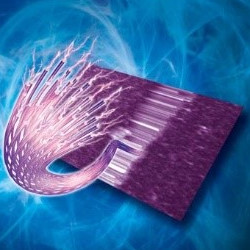The Mayans were the first people to use plastics, after learning how to process natural rubber. More recently, in 1907, the Belgian chemist Léo Baekeland presented the first entirely synthetic plastic raw material, which became known as Bakelite. Nowadays, there are constant developments in these materials, but they vary greatly. Combining the advantages of plastics (mouldable, lightweight) with the conductivity of metals is stimulating a lot of research.
Two research teams from CNRS and the University of Strasbourg have collaborated, headed by Nicolas Giuseppone (Charles Sadron Institute) and Bernard Doudin (IPCMS). The researchers want to “address one of the most important electronic challenges of the 21st century: miniaturising components down to a nanometric scale.” Their final goal is to develop fibres that can integrate miniaturised electrical devices such as flexible displays, solar cells, transistors, printed nanocircuits, and more.
Their research has led to the fabrication of highly conductive plastic fibres that are only a few nanometres thick. The most impressive part is that these fibres self-assemble when exposed to a flash of light. This inexpensive method provides fibres that are easy to handle, light and flexible. They are also capable of transporting current densities of over 2.106 A.cm-2, which is close to the capacity of copper wiring. These findings were patented by CNRS and published in Nature Chemistry.
Before arriving at these findings, the two teams began their work separately. Nicolas Giuseppone’s team studied the synthetic molecules ‘triarylamines’ closely. These molecules are usually used in the Xerox© photocopying process. They combine the advantages of metals and polymers. Their reaction to light and in solution is surprising: they spontaneously pile up in a regular order to form miniature fibres. These fibres measure hundreds of nanometres and appear in the form of a so-called ‘supramolecular’ assembly of several million molecules.
 Artist’s impression based on a real atomic force microscopy (AFM) image showing conductive supramolecular conductive fibres trapped between two gold electrodes spaced 100 nm apart. Each plastic fibre is composed of several short fibres and is capable of transporting electrical charges as efficiently as a metal.
Artist’s impression based on a real atomic force microscopy (AFM) image showing conductive supramolecular conductive fibres trapped between two gold electrodes spaced 100 nm apart. Each plastic fibre is composed of several short fibres and is capable of transporting electrical charges as efficiently as a metal.
Meanwhile, Bernard Doudin’s team worked on the molecule’s conductive properties. They applied an electrical field between two gold electrodes placed 100 nm apart and submerged in a solution containing the ‘triarylamine’ molecules. When they introduced a flash of light, fibres formed between the electrodes.
Light-triggered Self-construction of Supramolecular Organic Nanowires as Metallic Interconnects. Vina Faramarzi, Frédéric Niess, Emilie Moulin, Mounir Maaloum, Jean-François Dayen, Jean-Baptiste Beaufrand, Silvia Zanettini, Bernard Doudin, and Nicolas Giuseppone.
Nature Chemistry, En ligne le 22 avril 2012 (DOI: 10.1038/NCHEM.1332)